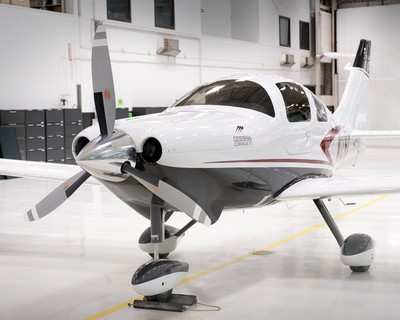Hypoxia Temporarily Incapacitated Pilot
 This is a long story, but a very
instructional read, and a good job done by the controllers, as well
as the young woman who found herself an accidental pilot in
command.
This is a long story, but a very
instructional read, and a good job done by the controllers, as well
as the young woman who found herself an accidental pilot in
command.
When the pilot of a small plane reported an oxygen problem over
Ohio last week and asked to “lose some altitude,” Ron
Lewis, an air traffic controller at Indianapolis Center, responded
immediately.
He told the pilot to descend to 17,000 feet from 23,000 feet,
and asked him what altitude he wanted.
Twelve-thousand feet, the pilot said. Lewis instructed him to
descend and maintain 11,000 feet, gave him the altimeter reading at
Columbus International Airport and asked if he needed any other
assistance.
“Negative,” the pilot responded.
Then nothing happened. Despite Lewis's repeated calls to the
pilot, the Cessna 400 didn't descend.
About five minutes later, a woman's voice came on the radio:
“We cannot figure out how to descend. And I don't think my
dad's feeling very well.”
Hypoxia had set in. The pilot’s body was deprived of
oxygen, and he was left feeling confused and disoriented. The
controllers at Indianapolis Center aren’t sure that he passed
out completely, but he was in no shape to fly the plane.
His daughter, who had no pilot’s training, had to take
over. With careful coaching from the Indianapolis Center and a
nearby private pilot, the woman was able to fly the airplane to a
lower altitude where the distressed pilot recovered enough to
eventually land the plane safely.
“This was truly a perfect example of aviators assisting
aviators in a very tense, potentially tragic situation,” said
Randy Smith, the air traffic manager at Indianapolis Center.
“We’ve had two or three similar situations in the last
year or so that have not turned out well. This was
perfect.”
For Lewis and his colleagues, what began as a routine request
soon tested their persistence, resourcefulness and aeronautical
knowledge.
About a minute after he told the pilot to descend, Lewis
instructed him to switch to a different frequency as he was about
to fly into another sector. The pilot read back the new frequency,
but didn’t switch his radio. And he still didn’t
descend.Then the women’s voice came on the radio and the
controllers had confirmation that they did indeed have a situation
to handle.
After several more radio exchanges, in which the pilot seemed to
drift in and out of lucidity, the pilot's daughter began talking to
the controllers.

File Photo
The pilot “was just having a hard time trying to figure
out what was going on,” said Rodney Riggs, support manager at
Indianapolis Center. “He couldn’t get his mind to work
for the aircraft to descend.”
The pilot’s daughter had never flown before and sounded
flustered, according to Bill Walker, another air traffic controller
at Indianapolis Center who stepped in to help Lewis.
But she had to learn how to operate the plane quickly, otherwise
she might become just as disoriented as her dad.
“I was concerned that what had happened to him was going
to quickly happen to her,” Walker said.
Fortunately, Walker is a private pilot and familiar with the
aircraft. And another pilot flying in the area who knew the
navigation equipment in the plane volunteered to help.
For 15 minutes or so, Walker and the other pilot, Jimmy Foote,
orchestrated a high-altitude distance-learning seminar.
“Since he had already passed out and she didn’t seem
like she was on top of her game either, we figured she didn’t
have much longer herself,” Foote said. “So really we
didn’t have much choice but to kick that autopilot off and
get her down best we knew how.”
The biggest obstacle at first was telling the woman how to turn
off the autopilot so she would be able to fly to a lower
altitude.
Foote “tried to get her to disconnect the autopilot by
looking for a disconnect switch on the pilot’s yoke,”
Walker said. “But she didn’t even know what the term
yoke meant. So we had to go back to basics to help her
out.”
Foote walked her through adjusting the trim, which turned off
the autopilot, and the throttle in a “nice, slow Southern
drawl” that Walker thinks helped calm the woman. “And
she settled in to a nice 600- to 700-foot-per-minute rate of
decent,” Walker said.
“The only thing I knew to do was to get her to bump the
electric trim on the yoke and just knock [the autopilot] off line
and try to get her to ease the power back just enough to give her a
stable approach down,” Foote said. “And fortunately for
everybody, it worked.”
Meanwhile, Walker and Lewis got the woman and assisting pilot
alone on a radio frequency and kept the airspace clear.
Since the plane had flown into another sector, Walker
coordinated with the controllers who were managing that
airspace.
“It was a group effort. There were five or six people in
constant coordination just to keep the planes away from what we
were doing,” Walker said. “We split the sector in two,
and some surrounding sectors took one or two of the
planes.”
To complicate matters, Walker was also giving Foote, who had
been flying from northern Ohio to Tupelo, Miss., vectors to make
sure he stayed close enough to continue to help.
And controllers at Indianapolis Center called Columbus Tower,
where a controller with a pilot’s license was standing by in
case a landing there was necessary.
As the plane descended through 16,000 feet, the distressed pilot
came back on the radio and said he wanted to continue on to his
destination of Stafford, Va.
“I didn’t want to be a hindrance to his situation,
so I said that’s fine, let’s just get you back on
course,” Walker recalled.
But the pilot stopped responding again. And after Walker called
twice, the pilot’s daughter was the one who responded.
She continued to fly the plane until they reached 14,000 feet,
at which point the pilot took over for good.
It took him a while to become fully aware of what was happening
and he initially wanted to continue flying to Virginia.
“He was in constant communication below 14,000 feet and he
sounded a little slow until he got very low,” Walker said.
“The other controllers who I spoke to afterward said until he
got down to about six or seven thousand feet, he was a little slow
on the transmissions, and really, really wanted to go
home.”
But Walker strongly advised him to land at a Zanesville
Municipal Airport in eastern Ohio, where the pilot made a safe,
straight-in approach to Runway 22 about an hour after entering
Indianapolis Center’s airspace.
Riggs said the Indianapolis Center will put together a briefing
on the event for all its controllers. And the facility will
continue to keep controllers aware of the signs and dangers of
hypoxia.
 Aero-News: Quote of the Day (05.13.25)
Aero-News: Quote of the Day (05.13.25) IAG Orders 76 Boeing, Airbus Airliners
IAG Orders 76 Boeing, Airbus Airliners FAA Shuts Down ATC Oversight Review Amid Scrutiny
FAA Shuts Down ATC Oversight Review Amid Scrutiny Montanas ADS-B Privacy Bill Signed Into Law
Montanas ADS-B Privacy Bill Signed Into Law Newark Falls Victim to More Equipment Outages
Newark Falls Victim to More Equipment Outages




